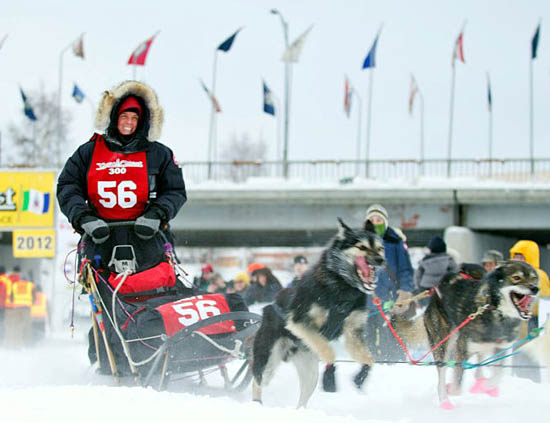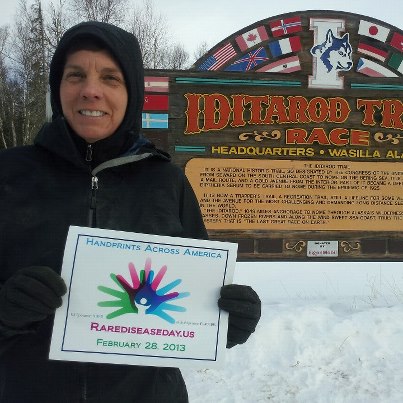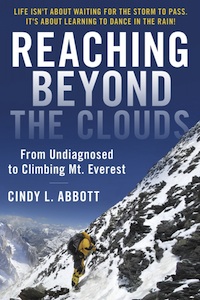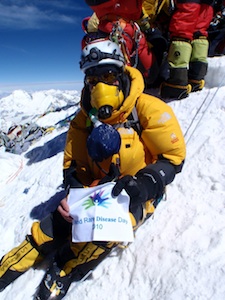

Cindy Abbott starts the 300 mile Yukon Quest Race, preparing for the Iditarod
Photo: Jan DeNapoli
As someone who has bungee jumped, climbed the Oakland Bridge, and stayed awake for 80 hours in a sleep deprivation study, I considered myself adventurous. Wrong! At 54, Cindy Abbott is running the Iditarod, a treacherous, 1000-mile dog sled race through the Alaskan wilderness. When she finishes, she will be the first woman to race the Iditarod and summit Mt. Everest, all while living with a rare, incurable disease.
Only 707 people have finished the Iditarod -- 127 females -- so starting to train at age 52 to run this race with my disease should have been impossible.
In 2007, this wife and mother was diagnosed with Wegener's Granulomatosis (a.k.a. Vasculitis), a potentially life-threatening disorder where the immune system attacks the blood vessels. She understands this extreme sport could be costly in more ways than one, but she hopes to raise awareness of the National Organization of Rare Disorders.
I spoke to Cindy just before she began her latest journey on March 3. She is in remission, but facing many obstacles, including a persistent cold and cough. But as Cindy wrote in her book, Reaching Beyond the Clouds, "Life isn't about waiting for the storm to pass; it's about learning to dance in the rain."
EYE: Were your lifelong goals to climb Mt. Everest and race in the Iditarod?
CINDY: Actually, neither one was. I watched a documentary about Mt. Everest when I was 48, and at that moment, I believed I had to climb that mountain when I had never even climbed a rock wall at a gym. Then a couple of months later, I was diagnosed with this disease, got blind in one eye, and was taking all this medication, but I still kept after it.

Three years later, I was on the summit of the highest mountain in the world. After, I was asked what I was going to do next... the Iditarod? And I thought, "That sounds like a good idea." I had never been on a dog sled. I contacted Lance Mackey -- he's won it four times in a row -- and sure enough, three-and-a-half years later, I'm racing in the Iditarod.
EYE: What was compelling you to climb Mt. Everest and then persevere after your diagnosis?
CINDY: I love adventure, the outdoors and experiencing different things. I like challenge and living life. But this race is even harder, something I never thought I would say after 54 days of living on Everest.
Some people with this disease can't even walk their dogs. The doctors would say I shouldn't be able to do this, but I kept climbing bigger mountains and nothing would happen.
EYE: What makes it so much more difficult?
CINDY: It's the physical aspect. On Everest there is a support team so they know where you are. There's no 'team' following you in the wilderness. You can go for a whole day and never see any civilization. You are out there with no vehicle or communication devices.
We have all the storms, wildlife, navigating and the caring for our dogs and gear. We have to endure physical and mental extremes and the cold! We run in 50 below temps, not counting wind chill.
EYE: Are you scared? Nervous? How are you feeling about this?
 CINDY: I'm not scared because I'm a pragmatist. I'm not nervous either. I'm anxious to get on the trail. On Everest, I went ten feet at a time. Whatever it was, I took tiny chunks; and in this case, it's each run with the dogs. In my brain, I think I have to get from here to here.
CINDY: I'm not scared because I'm a pragmatist. I'm not nervous either. I'm anxious to get on the trail. On Everest, I went ten feet at a time. Whatever it was, I took tiny chunks; and in this case, it's each run with the dogs. In my brain, I think I have to get from here to here.
EYE: How much does living with this disease affect you now?
CINDY: I'm blind in one eye. I have compromised vision in the other eye. I have arthritis in my back that is very severe. I have to take medications all the time. Now I have this cold. It's like a repeat of Everest where I was sick for six weeks, and it didn't get better until I got off the mountain.
When I got diagnosed, I read that the time from diagnosis to death was five months! But they've extended that because they've come out with new drugs, and they caught mine before the kidney and lung involvement.
Some people with this disease can't even walk their dogs. The doctors would say I shouldn't be able to do this, but I kept climbing bigger mountains and nothing would happen. So they couldn't tell me I couldn't. When I got to the summit of Everest and came back, I immediately went to the doctors and they were just stunned.
I was the 40th American female to summit Everest. Only 707 people have finished the Iditarod -- 127 females -- so starting to train at age 52 to run this race with my disease should have been impossible.
 EYE: Why is this race so important?
EYE: Why is this race so important?
CINDY: It's because of my 14 years of going to doctors, having my body basically disintegrating, and everyone telling me, "We don't know," when there was an answer the whole time. The National Organization for Rare Disorders can help send people to doctors.
EYE: Not to jump ahead, but what would be the next cool thing for you to do?
CINDY: My husband cringes when anybody asks me that. He says, "My wife doesn't seem to think she doesn't have any limits." I've always wanted to walk on the moon. That would be the ultimate for me!
EYE: Do you think people take life for granted?
CINDY: I think people get caught up in what they're supposed to do or they just don't try. I am so grateful for my husband because we are soulmates. Somehow I can rally up and do these incredible things. Dog sled racing and being away from family and dealing with the disease and the cold is hard, but I'm so happy that I can do it. When I cross that finish line at the Iditarod, I don't have any idea how that's going to feel.
EYE: What is the biggest challenge you are facing?
CINDY: My vision is not good. When I'm moving in the Alaskan wilderness at dark during a storm with no trail markers, my vision problems are probably the scariest thing for me. My dogs rely on me.
EYE: If there is anyone who can do it, I'm pretty sure it's you!
CINDY: I'm pretty sure, too. I have a lot of confidence in myself because of the way I approach things. Just take this run, keep my dogs safe and healthy and then think about the next run. Do it step-by-step and be smart.
A version of this article with Cindy Abbott appeared on The Women's Eye Online Magazine.
Follow The Women's Eye on Twitter: @TheWomensEye